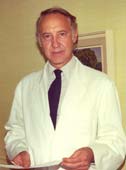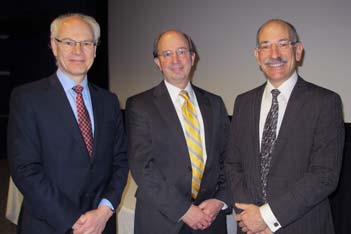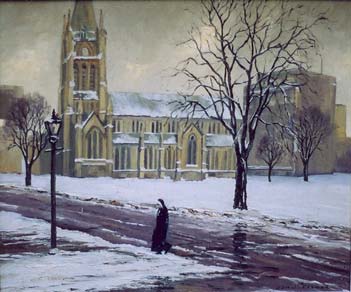The John Palmer Lecture
ADVANCES IN HEPATIC SURGERY
 John Palmer
|
John Palmer lived from
1925-1984. He trained
in general and plastic
surgery at the University
of Toronto and then
completed fellowships
in Edinborough in plastic
surgery and colorectal
surgery at St. Mark’s
in London. He was a
self -described "head to
tail surgeon". Among
his many talents were
playing the trombone,
refinishing furniture and painting beautiful landscapes,
two of which were shown by Paul Greig during his
thoughtful introduction of professor Michael A. Choti,
this year’s Palmer lecturer.
A graduate of Yale, University of Pennsylvania
and Memorial Sloan Kettering, Professor Choti joined
the John Hopkins Faculty in 1992. He has served as
director of the Hopkins’ Surgical Oncology Fellowship
and Chief of the Surgical Oncology Program. His
research is focused on ultrasound guided ablation techniques
for liver tumours. He is the Jacob Handelsman
Professor of Surgery, named for a gifted surgeon with
interests and avocations similar to those of John Palmer.
Hepatic surgery is evolving in important ways. The
mortality for ablation or resection of hepatic metastasis
is now at 1% or lower and the five-year survival for
hepatic resections for cancer exceeds 50%. Where resection
was previously limited to one or two metastases,
it is now common practice to resect even patients with
many metastases. These dramatic advances are related
to the improvements in preoperative therapy, imaging
and surgical technique. The imaging requires a fusion of
surgery and imaging techniques analogous to the work
that is being done in urologic, cardiovascular, and neurosurgery.
Unlike the brain or prostate, the liver moves
with respiration and position, and the use of registered
preoperative images in the operative theatre is more challenging.
Additional metastases are found at exploration in
10% of cases. Another challenge is the disappearance of
tumours that were imaged in the pretreatment interval,
as they are often unfindable following chemotherapy. It
is nevertheless important to resect the sites, as residual
tumour cells are generally present despite their apparent
disappearance on intra-operative imaging. The Hopkins
group - comprised of engineers, surgeons, medical oncologists,
and radiologists are actively exploring the use of
more advanced techniques for imaging and resection. The
group has patented a robotic ultrasound tool licensed to
Intuitive Surgical. Such a device can be used to improve
minimally invasive robotic procedures using image-guidance,
including cancer ablation. Ablation techniques currently
in use include chemical ablation (using ethanol or
acetic acid), and thermal ablation using radiofrequency
or microwave energy. The Choti team has developed
a staging system based on the surgeons’ confidence in
the completion of the ablation. In this way, this form
of therapy may be able to achieve comparable results to
that of more invasive resectional therapy. They are working
with three dimensional ultrasound, motion tracking
using video-gaming systems, and fusion of CT and MRI
with operative ultrasound to resolve some of the imaging
problems. Some metastases are isoechoic, i.e. they cannot
easily be found by reason by their hypo or hyper echoicity,
even if they are evident on CT. They are working with
GE, Siemens, Phillips and other manufacturers to resolve
these challenges. To improve conspicuity, they are adding
elastography - a technique to visualize differences in stiffness
that results from thermal destruction.
The current novel robotic probe works with high
frequency therapeutic ultrasound to shape the ablation
field.
 Paul Grieg, Michael Choti and Ori Rotstein
|
John Trachtenberg asked about the use of magnetic
resonance thermography, which he is employing successfully
in prostate cancer ablation. Professor Choti
felt that the system was more difficult in the hepatic
application as the apparatus is awkward and expensive.
Andy Smith asked about the drift of surgery toward
radiology and radiology towards surgery. Choti answered
that, indeed, the specialties are blending somewhat, as
are the cultures. Radiology residents are getting more
adept at patient care as interventional oncologists; they
now see and follow patients. Hepatobiliary surgeons
are learning radiology, though the specialties are clearly
interdependent. Paul Greig asked about the use of ultrasound
contrast to strengthen imaging. Choti answered
that the Hopkins group is not exploring this at present,
but the Europeans are very active in contrast ultrasonography.
Ori Rotstein asked about the interaction of
surgeons and engineers. Choti answered that it is hard
to bring the mindsets together. "Surgeons are trained in
mechanistic hypothesis testing, whereas the engineers’
thinking is based on system development and validation.
They design robots and create software. The co-principal
investigative model is in progress".
M.M.
|
|
John Angus Palmer was born in Meaford Ontario in 1925. He attended school in the Georgian Triangle and went to medical school at the University of Toronto. Dr Palmer went on to complete the Gallie Course in General and Plastic Surgery in Toronto.
After obtaining his FRCSC, John was awarded the prestigious Nuffield Scholarship to do fellowship training in reconstructive surgery at the University of Edinburg. After this, he did additional training in colorectal surgery at St Marks.
In 1952 he returned to Toronto as what we would now call a Surgical Oncologist. He referred to his specialty as "Head and Tail Surgery".
John Palmer developed interest and expertise in a very broad range of general surgery, Head and Neck, Head and Neck reconstruction, Thyroid, Parathyroid, GI malignancy, Skin cancer, melanoma, Perianal malignancy, and Radiation enteritis. More Head to tail, than Head and Tail.
He did not publish prolifically but what he did publish was pivotal, particularly his papers on radiation induced injuries to the GI tract and his work on Primary Hyperparathyroidism.
John Palmer was a master surgeon, an astounding technician, a thoughtful clinician and gifted teacher.
John had numerous and eclectic interests outside of surgery: his family, painting, collecting art, playing the trombone, collecting and refinishing antiques, carving decoys, anatomy, skiing, boating: to name a few, he also mixed a mean pitcher of Martinis. As a centennial project in 1967, he and his family dismantled a pioneer log house and reconstructed it near their family cottage in Dwight Ontario. They then opened it to the public as an antique shop. It was charming.
Dr. Palmer was a very accomplished painter. In February of 1973 he held his first one-man show of fifty landscapes at the Framing Gallery, Toronto. Here are 2 examples of his work.
John Palmer died prematurely in 1984 of ironically, malignant disease. He is survived by his wife Margot, his son John, his daughters Valerie, Marilyn and Jenifer.
 John Palmer - Cathedral
|
 John Palmer - Swamp Highway 60 North of Huntsville
|
|
|